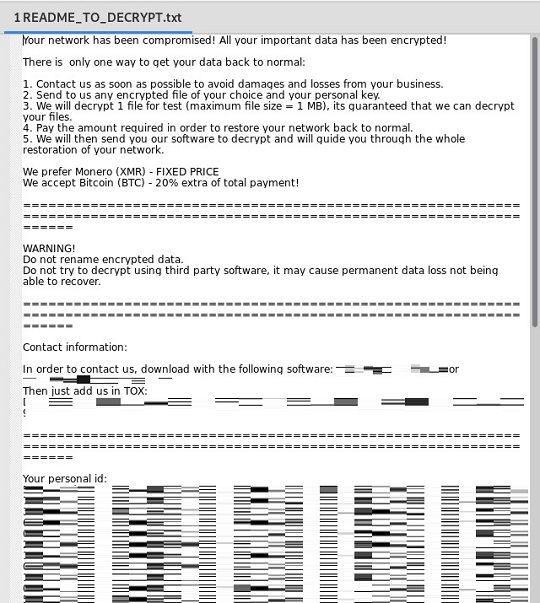Ransom.Linux.KUIPER.THAAHBD
Linux


Threat Type: Ransomware
Destructiveness: No
Encrypted:
In the wild: Yes
OVERVIEW
This Ransomware arrives on a system as a file dropped by other malware or as a file downloaded unknowingly by users when visiting malicious sites.
It drops files as ransom note. It avoids encrypting files with the following file extensions.
TECHNICAL DETAILS
Arrival Details
This Ransomware arrives on a system as a file dropped by other malware or as a file downloaded unknowingly by users when visiting malicious sites.
Other Details
This Ransomware does the following:
- It prints the number of processors and execution logs to the console.

- It checks if the file size is greater than 4,493,148,150 bytes. Only a certain percentage of the file will be encrypted.
- It checks if the file extension is any of the following. These files will be encrypted in its entirety regardless of the file size.
- .sql
- .txt
- .db
- .json
It accepts the following parameters:
- -help → Displays the help menu.
- -kill {yes|no} → Kill loop for taskmgr, cmd, regedit, powershell. (Default: no)
- -note {yes|no} → Paste note after directory change and encryption. (Default: yes)
- -p {path} → Target folder to encrypt files
- -reboot {yes|no} → Reboot after end encryption of all files or disks. (Default: yes)
- -rename {yes|no} → Rename file after encryption. (Default: yes)
- -bm {yes|no} → Encrypt big files first (Default: yes)
Ransomware Routine
This Ransomware avoids encrypting files found in the following folders:
- /bin
- /boot
- /dev
- /etc
- /initrd
- /lib
- /lib64
- /libx32
- /opt
- /proc
- /root
- /run
- /sbin
- /srv
- /sys
- /tmp
- /usr/
- /var
It appends the following extension to the file name of the encrypted files:
- .kuiper
It drops the following file(s) as ransom note:
- {Encrypted directory}\README_TO_DECRYPT.txt

It avoids encrypting files with the following file extensions:
- .bak
- .bat
- .bin
- .blf
- .cfg
- .cmd
- .com
- .dat
- .dll
- .elf
- .exe
- .ini
- .lnk
- .msi
- .rtf
- .sys
- .tmp
SOLUTION
Step 1
Trend Micro Predictive Machine Learning detects and blocks malware at the first sign of its existence, before it executes on your system. When enabled, your Trend Micro product detects this malware under the following machine learning name:
- Troj.ELF.TRX.XXELFC1DFF036
Step 2
Scan your computer with your Trend Micro product to delete files detected as Ransom.Linux.KUIPER.THAAHBD. If the detected files have already been cleaned, deleted, or quarantined by your Trend Micro product, no further step is required. You may opt to simply delete the quarantined files. Please check the following Trend Micro Support pages for more information:
Step 3
Restore encrypted files from backup.
Did this description help? Tell us how we did.


